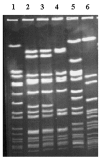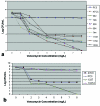Clinical implications of varying degrees of vancomycin susceptibility in methicillin-resistant Staphylococcus aureus bacteremia
- PMID: 12781004
- PMCID: PMC3000153
- DOI: 10.3201/eid0906.030001
Clinical implications of varying degrees of vancomycin susceptibility in methicillin-resistant Staphylococcus aureus bacteremia
Erratum in
- Emerg Infect Dis. 2004 Jan;10(1):160
Abstract
We conducted a retrospective study of the clinical aspects of bacteremia caused by methicillin-resistant Staphylococcus aureus (MRSA) with heterogeneously reduced susceptibility to vancomycin. Bloodstream MRSA isolates were screened for reduced susceptibility by using brain-heart infusion agar, including 4 mg/L vancomycin with and without 4% NaCl. Patients whose isolates exhibited growth (case-patients) were compared with those whose isolates did not (controls) for demographics, coexisting chronic conditions, hospital events, antibiotic exposures, and outcomes. Sixty-one (41%) of 149 isolates exhibited growth. Subclones from 46 (75%) of these had a higher MIC of vancomycin than did their parent isolates. No isolates met criteria for vancomycin heteroresistance. No differences in potential predictors or in outcomes were found between case-patients and controls. These data show that patients with vancomycin-susceptible MRSA bacteremia have similar baseline clinical features and outcomes whether or not their bacterial isolates exhibit growth on screening media containing vancomycin.
Figures


References
-
- Centers for Disease Control and Prevention. Staphylococcus aureus resistant to vancomycin–United States, 2002. MMWR Morb Mortal Wkly Rep. 2002;51:565–7. - PubMed
-
- Centers for Disease Control and Prevention. Public heath dispatch: vancomycin-resistant Staphylococcus aureus—Pennsylvania, 2002. MMWR Morb Mortal Wkly Rep. 2002;51:902. - PubMed
Publication types
MeSH terms
Substances
Grants and funding
LinkOut - more resources
Full Text Sources
Medical
Molecular Biology Databases
Miscellaneous
